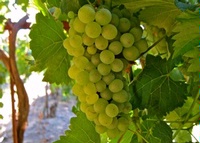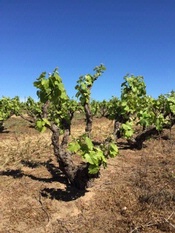|
|
 |

The Chenin Blanc, or just Chenin to Loire Valley producers, is a grape of marvelous potential that is too often overlooked in the marketplace. Its origins appear to be in the Loire Valley of France in Anjou, where it was called the Plant d’Anjou. It was transported upstream in the sixteenth century to the monastery of Montchenin in Touraine. The grape thrived in the Touraine vineyards and took the name of Chenin after the monastery. It is a white grape that is now planted across several continents. Given an ideal combination of soil, climate, viticultural skill and expert winemaking, the Chenin Blanc can yield some of the world's most intensely aromatic and flavorful white wines. Sadly, these conditions are frequently not present and much of the Chenin Blanc wine made today falls far short of the grape's potential.

Chenin Blanc Grapes in the Loire Valley
Chenin, when planted in an amenable soil, is a vigorous grower that can produce a large crop if not controlled. It buds early; increasing its susceptibility to spring frosts and it forms fairly tight clusters that can succumb not only to botrytis cinerea, the “noble rot” of dessert wine fame, but also various forms of decidedly ignoble rot along with powdery mildew. The Chenin ripens at mid-harvest in most places. Its parentage is still unclear, but it appears it may be an offspring of Savagnin and an unknown variety. It also may be a sibling of Sauvignon Blanc and Trousseau. It is most famous, although not most planted, in the Loire Valley of France.
The best Chenin Blanc wines arguably still come from the Anjou and Touraine regions of France's Loire Valley. The Anjou region produces excellent dry, sweet, and sparkling renditions of the Chenin Blanc. The small village of Savennières here is noted for its excellent dry whites. Grown on the south-facing slopes surrounding the village, the Chenin Blanc grapes yield concentrated wines that are remarkably long-lived. The bouquet of a good Savennières combines lovely honey and floral scents with the apple and pear fruit aromas of the Chenin Blanc. Two famous Savennières vineyards, Coulée de Serrant and Roche aux Moines, have individual AOCs within the appellation. There are very few Savennières producers and the standard of quality is high. Although it can be difficult to find, the wine of Savennières is well worth the effort to seek out.
Near Savennières is the confluence of the north-flowing river Layon and the Loire. The slopes of the Layon Valley are known as the Coteaux du Layon and are the source of wonderful dessert wines. The Chenin Blanc grapes ripen well here and climatic conditions are often favorable for the formation of the "noble rot." When temperature and humidity conditions are just right late in the ripening season, the grapes are infected with the botrytis cinerea mold that extracts some of the water from the grape berries, thus shriveling the skin and concentrating the sugar level within the grapes. The result is a fabulously perfumed, honeyed, sweet and luscious wine capable of aging for 20-30 years and more. Two areas within the Coteaux du Layon - Quarts de Chaume and Bonnezeaux - are noted for their outstanding wines and have their own appellations.
The best sparkling Chenin Blancs in Anjou come from the village of Saumur and its surroundings. The grapes, grown on chalky soils here, provide crisp, tart wines that are ideal for sparkling wine production. The traditional methods used for Champagne production are employed in Saumur as well, giving the finished wine not only the delicate, appley/floral style of the Chenin Blanc, but also the subtle, yeasty complexity that comes from the secondary fermentation in the bottle. A fine Saumur Mousseux is a deliciously crisp and refreshing bubbly that is an affordable alternative to true Champagne. In recent years, producers of still Saumur, led by Domaine Guiberteau, have enhanced the recognition of Chenin Blanc without bubbles from this traditional appellation.
Moving upstream on the Loire from Anjou, we come the Touraine region. Here the Chenin Blanc grapes are fashioned into the famous dry, sweet, half-sweet, pétillant and fully sparkling wines of Vouvray. The chalk-based soils of Vouvray (and the neighboring village of Montlouis) are rich in mineral content and yield profoundly aromatic wines blessed with rich fruit as well as the firm acidity that allows for extended aging. The best estates, like Domaine Huet, produce wines that can improve for half a century.

Old Bush Vine Chenin Blanc in South Africa
Chenin Blanc is grown in many other wine regions around the world. It is the most widely planted white grape variety in South Africa, where it is sometimes known as Steen. In fact, with acreage triple that of the French vineyard area, South Africa is easily the world's largest producer of Chenin Blanc. The styles range from affordable and easy drinking to weighty, barrel-aged bottlings. A new wave of producers is seeking out old, dry-farmed plots of Chenin and crafting the New World’s most impressive Chenins. Producers like Alheit, Sadie Family and Badenhorst along with Ken Forrester, Raats Family and de Morgenzon, among others, are becoming famous as top-class Chenin estates.
In the Western Hemisphere, Chenin Blanc is experiencing resurgence in California. Once widely planted throughout wine country, most of the California Chenin vineyards have been pulled out over the last 20 years and replaced with Chardonnay, Pinot Grigio or other varieties more popular in the marketplace. Most of the 5000 or so acres of Chenin that remain are planted in the Central Valley, where they have been long utilized by jug wine bottlers. In the cooler growing regions, however, California Chenin Blanc can yield very fine wines. A few producers like Chappellet, Husch, Pine Ridge and Dry Creek continued to produce Chenin through those lean years. Today, they are joined by a new wave of Chenin enthusiasts. Up and coming wineries like Sandlands, LoFi and Lieu Dit are all producing excellent quality wines. There are around 200 acres of Chenin planted in Washington State as well, likely with more on the way if the grape continues to grow in popularity.
Although Argentine vineyards encompass some 5000+ acres of Chenin, few of them reach the market as single variety wines. Most often, they are used as a blending variety with Chardonnay or another grape. As Chenin grows in popularity and demand around the world, we may see Argentine producers bottling their Chenin on its own.
Those seeking variety and quality as well as value in their wine selections would do well to consider adding more Chenin Blanc to their vinous repertoire. This is a forgotten grape variety that has much to offer for those willing to seek out the highest-quality renditions.
|
 |
|